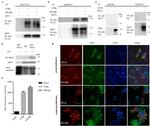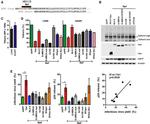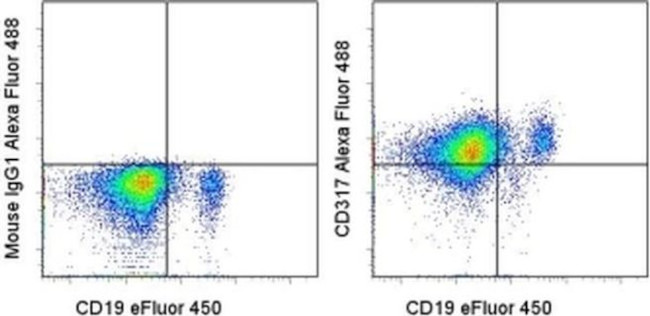Search Thermo Fisher Scientific
Invitrogen
CD317 (BST2, PDCA-1) Monoclonal Antibody (26F8), Alexa Fluor™ 488, eBioscience™
FIGURE: 1 / 3
CD317 (BST2, PDCA-1) Antibody (53-3179-42) in Flow



Product Details
53-3179-42
Species Reactivity
Published species
Host/Isotype
Recommended Isotype Control
Class
Type
Clone
Conjugate
Excitation/Emission Max
Form
Concentration
Purification
Storage buffer
Contains
Storage conditions
Shipping conditions
RRID
Product Specific Information
Description: This 26F8 monoclonal antibody reacts with human CD317 (also known as BST2 and tetherin). CD317 is a 30-36-kDa type II transmembrane protein expressed on B cells and bone marrow stromal cells. Although reports have indicated that CD317 mRNA is detectable in activated T cells, protein expression in freshly isolated primary T cells and macrophages is undetectable. Moreover, certain T cell lines, such as Jurkat, do not express detectable levels of CD317 protein. However, CD317 expression can be induced in many cell types (e.g., T and B cells, 293T, and HeLa) by IFNalpha treatment. CD317 has been associated with pre-B cell growth and the terminal differentiation of plasma B cells. More recently, this molecule has been reported to prevent HIV-1 virion release from the surface of infected cells, leading to reuptake and degradation of the virus. This activity is inhibited by the HIV-1 accessory protein Vpu. CD317 has been identified as the ligand for the ILT7 receptor.
Applications Reported: This 26F8 antibody has been reported for use in flow cytometric analysis.
Applications Tested: This 26F8 antibody has been pre-titrated and tested by flow cytometric analysis of normal human peripheral blood cells. This can be used at 5 µL (0.25 µg) per test. A test is defined as the amount (µg) of antibody that will stain a cell sample in a final volume of 100 µL. Cell number should be determined empirically but can range from 10^5 to 10^8 cells/test.
Excitation: 488 nm; Emission: 519 nm; Laser: Blue Laser.
Filtration: 0.2 µm post-manufacturing filtered.
Target Information
BST2 (CD317, HM1.24 antigen, DAMP-2, tetherin) is an integral membrane protein that is involved in the development and growth of B-cells. The surface expression of BST2 on fibroblast cell lines facilitated the stromal cell-dependent growth of DW34, a pre-B-cell line. BST2 is highly expressed during B-cell development, from pro-B precursors to plasma cells, T-cells, monocytes, NK cells and DCs (at protein level), and myeloma cells. Research studies have shown that BST2 also functions as an inhibitor of retrovirus release from human cells whose activity is antagonized by the HIV-1 accessory protein, Vpu. While BST2 causes retention of virions on cell surfaces or endocytosis into BST2-positive compartments, its depletion abolished the viral requirement for Vpu for virus release, an activity that may represent a potential therapeutic strategy for the treatment of HIV/AIDS. Another disease associated with BST2 dysfunction is stomatitis.
For Research Use Only. Not for use in diagnostic procedures. Not for resale without express authorization.
How to use the Panel Builder
Watch the video to learn how to use the Invitrogen Flow Cytometry Panel Builder to build your next flow cytometry panel in 5 easy steps.
Bioinformatics
Protein Aliases: Bone marrow stromal antigen 2; BST-2; CD317; HM1.24 antigen; NPC-A-7; PDCA-1; Tetherin
Gene Aliases: BST2; CD317; TETHERIN
UniProt ID: (Human) Q10589
Entrez Gene ID: (Human) 684

Performance Guarantee
If an Invitrogen™ antibody doesn't perform as described on our website or datasheet,we'll replace the product at no cost to you, or provide you with a credit for a future purchase.*
Learn more
We're here to help
Get expert recommendations for common problems or connect directly with an on staff expert for technical assistance related to applications, equipment and general product use.
Contact tech support

